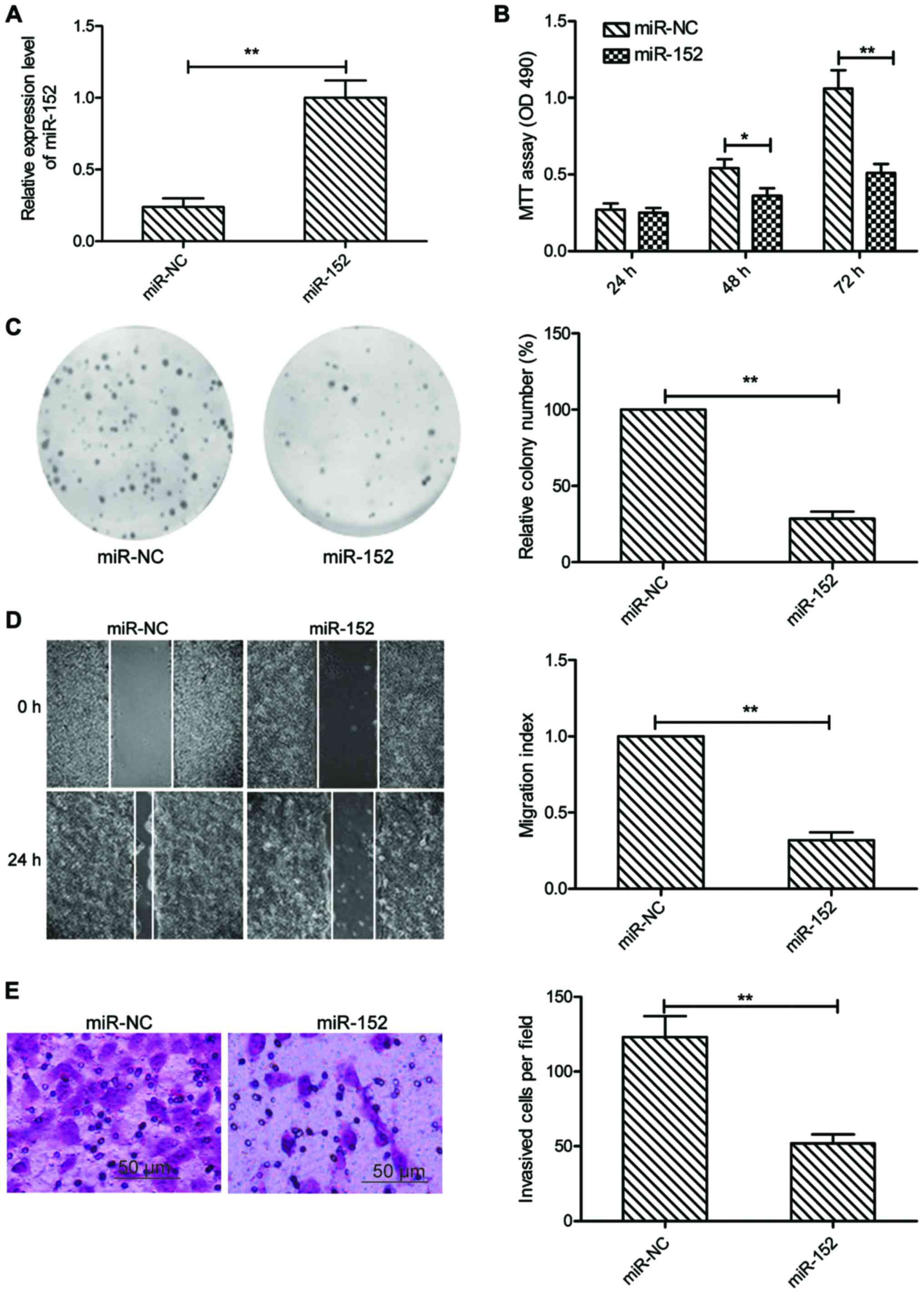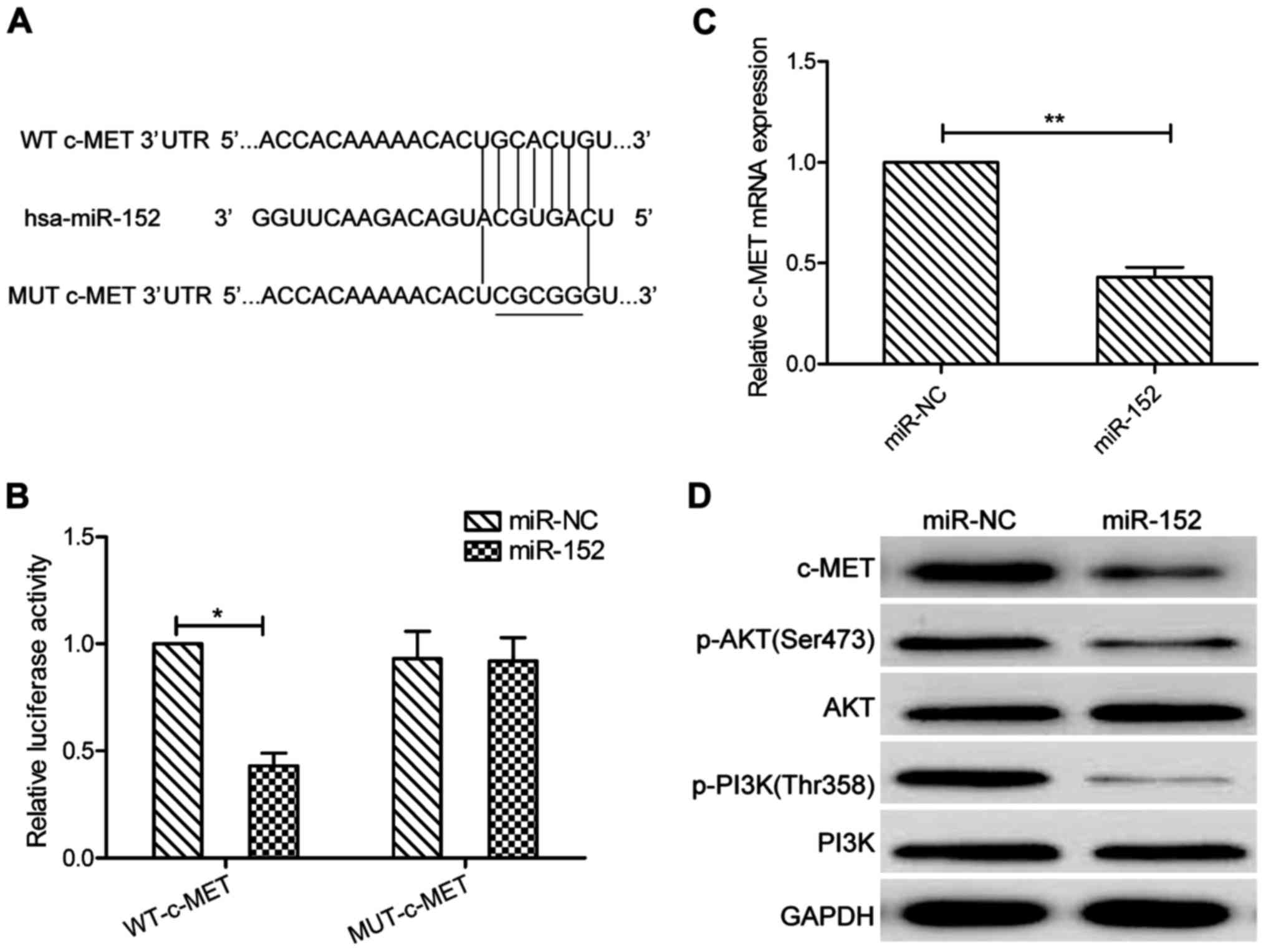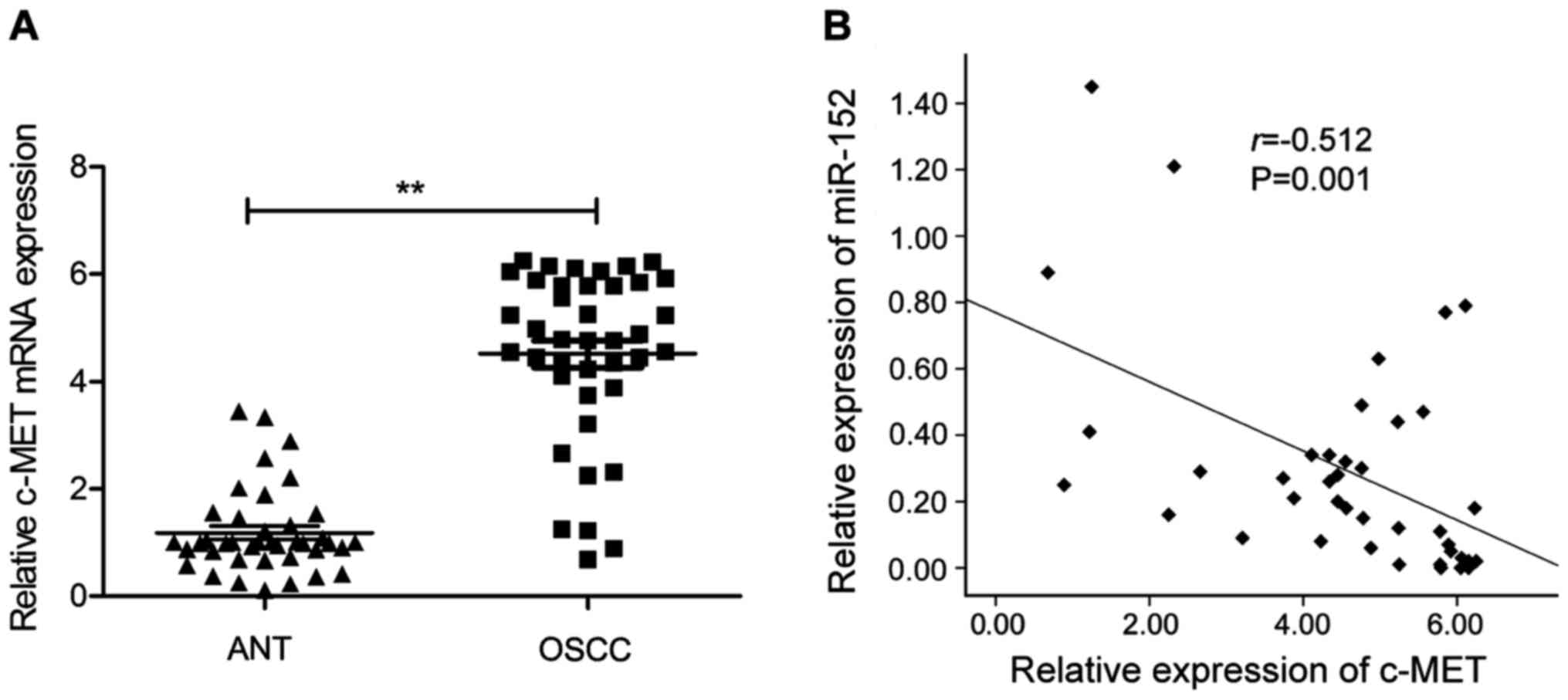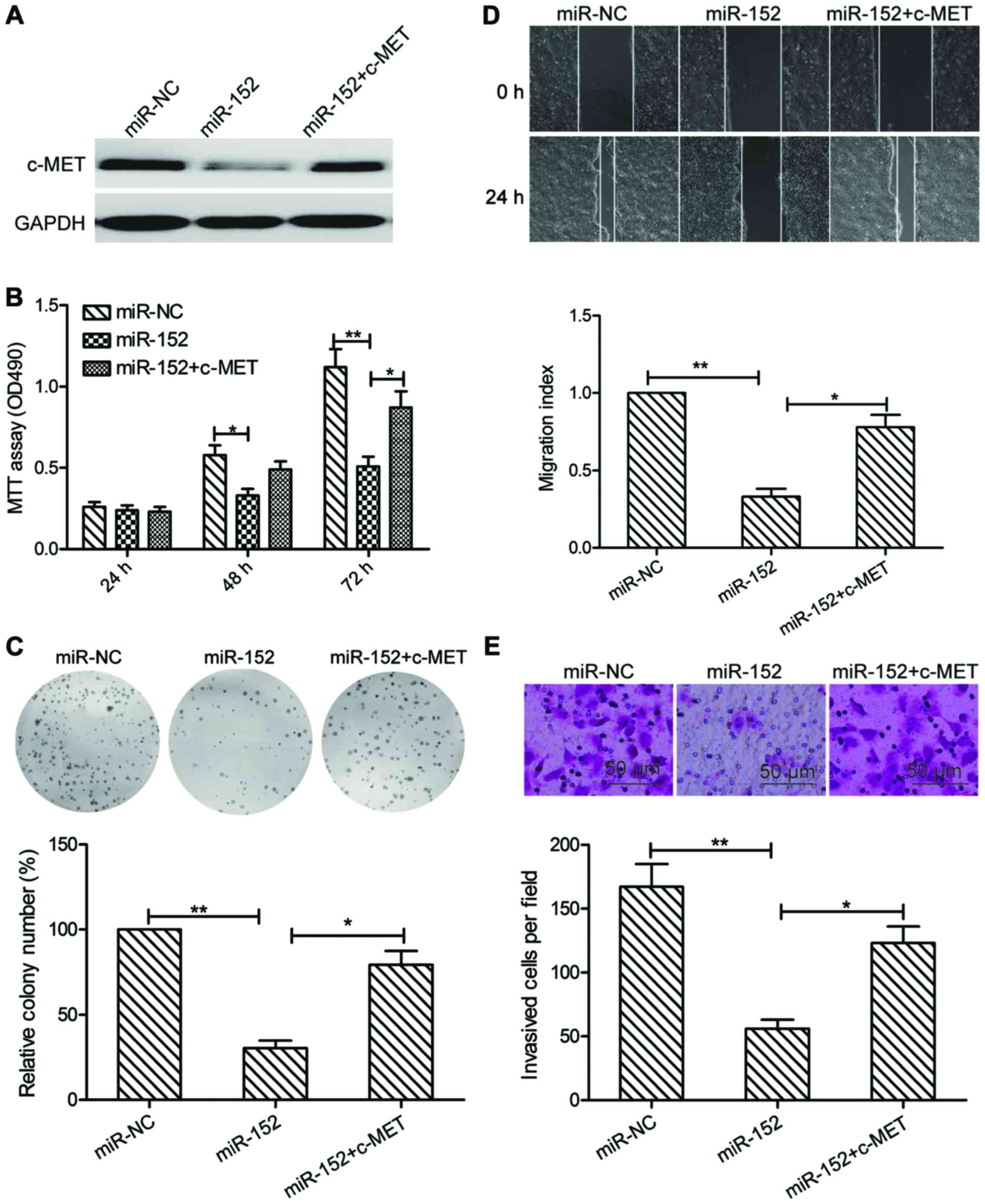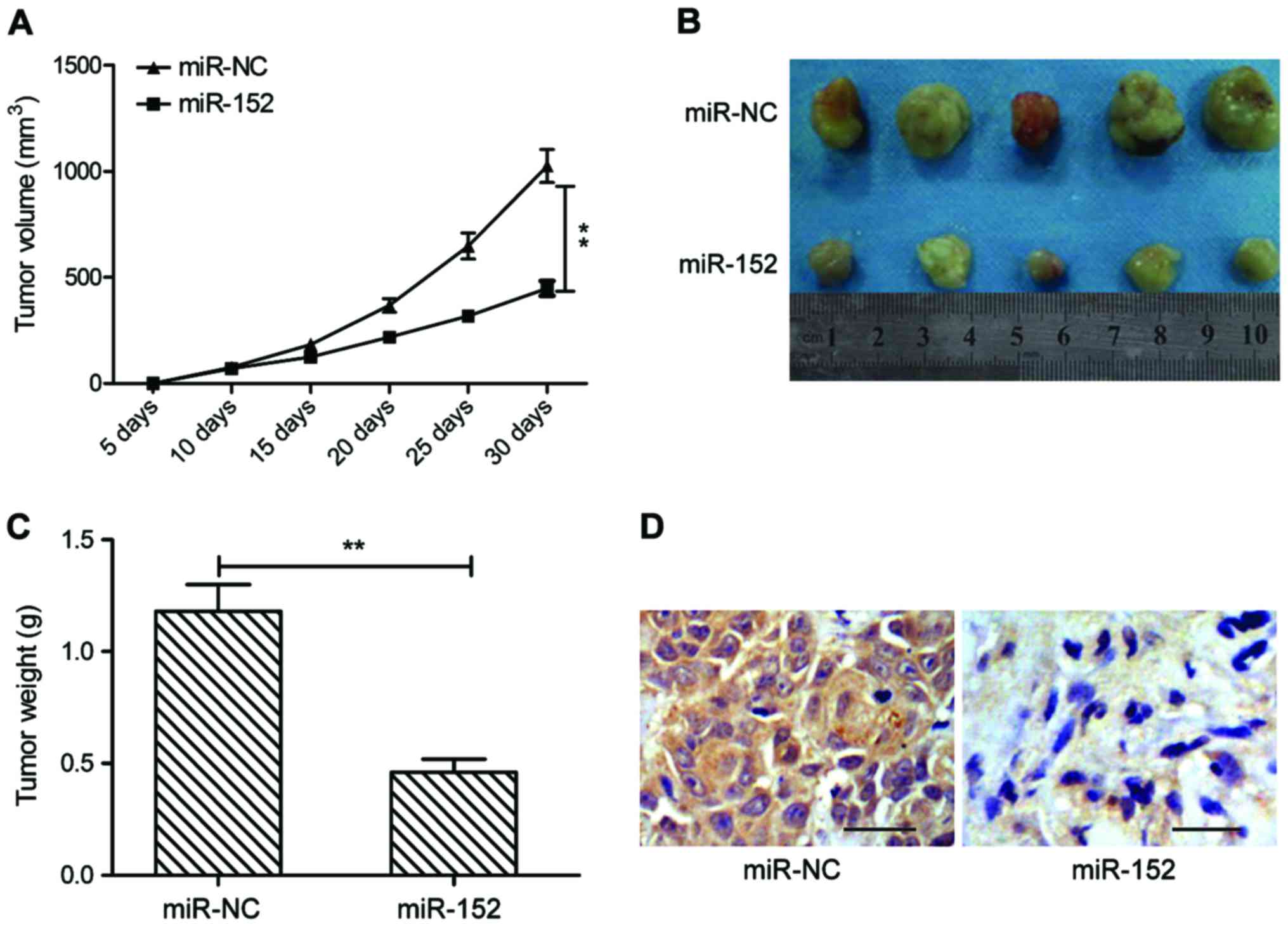Function of miR‑152 as tumor suppressor in oral squamous cell carcinoma cells by targeting c‑MET
Retraction in: /10.3892/or.2022.8254
- Authors:
- Published online on: December 15, 2017 https://doi.org/10.3892/or.2017.6157
- Pages: 1173-1180
Abstract
Introduction
Oral squamous cell carcinoma cells (OSCC) is the most common oral cancer, and accounts for ~90% total oral cancers (1). Despite considerable improvements in therapeutic strategies for OSCC over the past two decades, the 5-year survival rate of OSCC has not improved significantly and its incidence continues to increase among young people and women (2,3). Therefore, exploring novel molecular mechanisms involved in development and progression of OSCC is urgently needed for identifying novel and effective therapeutic targets.
MicroRNAs (miRNAs) are a class of highly conserved endogenous, single-stranded, small non-protein-coding RNAs comprising ~18–25 nucleotides that inhibit gene expression at the post-transcriptional level by directly binding to the 3′-untranslated region (3′UTR) of messenger RNAs (mRNAs) (4). Through repressing the target gene, miRNAs are able to regulate diverse biological processes, such as cell proliferation, cell migration, apoptosis, differentiation, development, immunity, and metabolism (5,6). Importantly, miRNAs are dysregulated in various types of cancer as oncogenes or tumor suppressors (7,8). For OSCC, number of miRNAs have been identified to be involved in progression and development of OSCC (9,10), and to be used as diagnosis marker and therapy target.
MicroRNA-152 (miR-152) has been shown to be downregulated, and function as a tumor suppressor in many types of cancers, including gastric cancer (11), colorectal cancer (12), breast cancer (13), non-small lung cancer (14), cervical cancer (15), and prostate cancer (16). However, its potential role and mechanism in regulating OSCC carcinogenesis and progression remains unclear. This study aimed to reveal the exact role as well as the relevant mechanism of miR-152 in the regulation of OSCC cell proliferation and invasion.
Materials and methods
Tissue samples
Total of 40 paired fresh surgically resected OSCC tumors and matched adjacent normal tissues were obtained from OSCC patients who were diagnosed, treated, and followed-up at the Department of Oral and Maxillofacial Surgery, School and Hospital of Stomatology, Jilin University (Changchun, China). Fresh frozen tissues were immediately frozen in liquid nitrogen and stored in liquid nitrogen until RNA extraction. All samples were confirmed by pathological examinations. Written informed consent was obtained from all participants. This study was approved by the Ethics Committee of School and Hospital of Stomatology, Jilin University (Changchun, China). Patients who had received chemotherapy or radiotherapy prior to surgery were excluded. Clinical parameters, including pathological features and clinical stage, were retrospectively harvested and are presented in Table I.
Cell culture and transfection
The human normal oral keratinocytes (hNOKs) and four human OSCC cell lines, including Tca8113, OSCC-15, SCC-9, and SCC-25, were obtained from American Type Culture Collection (Manassas, VA, USA), and cultured in DMEM/Nutrient Mixture F12 (Hyclone, Logan, UT, USA) supplemented with 10% fetal bovine serum (FBS, Gibco, USA), 100 U/ml penicillin (Sigma-Aldrich, St. Louis, MO, USA), or 100 µg/ml streptomycin (Sigma-Aldrich) in a humidified incubator containing 5% CO2 at 37°C. The cells from passage 4 were used for all the experiments.
miR-152 mimic or corresponding negative control (miR-NC) was brought from GenePharma (Shanghai, China). The c-MET overexpression vector (pCDNA3.1-c-MET, lack of 3′UTR) was granted from Yue Zhao (Jilin University). Transfection was performed using the Lipofectamine™ 2000 reagent (Invitrogen, Carlsbad, CA, USA) following the manufacturer's protocol.
Quantitative real-time PCR
Total RNA was extracted from the cultured cells or tissues using TRIzol (Invitrogen) according to the manufacturer's instructions. A dual-beam ultraviolet spectrophotometer (Eppendorf, Hamburg, Germany) were used to determine purity and concentration of total RNA. Then, total RNA was reverse transcribed to cDNA using a PrimeScript® RT reagent kit (Takara Biotechnology Co., Ltd., Dalin, China) or the miScript Reverse Transcription kit (Qiagen, Hilden, Germany). The PCR were performed using SYBR premix real-time PCR reagent (Takara) under an ABI7900 real-time PCR system (Applied Biosystems, Foster City, CA, USA). The primers for miR-152 and U6 were brought from Applied Biosystems. The primers for c-MET and GAPDH were used in this study as described previously (17). U6 and GAPDH were applied as internal controls for miR-152 and c-MET mRNA, respectively. Relative quantification was analyzed using the comparative 2−ΔΔCt method.
Cell proliferation assay
3-(4,5-dimethylthiazol-2-yl)-2,5-diphenyl tetrazolium bromide (MTT) assay kit (Sigma-Aldrich) were used to measure cell proliferation. In brief, the transfected cells were seeded in a 96-well plate (1×103 cells/well) and cultured for 1–3 days. After incubated for 24, 48 and 72 h respectively, 25 µl of MTT (10 mg/ml) was added to each well and cultured for 4 h. Then, the supernatant was removed, and 150 µl of dimethyl sulfoxide (DMSO, Sigma-Aldrich, St. Louis, MO, USA) was added to each well for 10 min at room temperature. The absorbance at 490 nm was detected with a microplate reader (Bio-Rad, Hercules, CA, USA).
Colony formation assay
Transfected cells were seeded in 6-well plates (500 cells per well) and allowed to grow for 10 days to determine their colony-forming ability. After 70% ethanol fixation, the plate was stained with 0.1% crystal violet for 5 min (Sigma). Cell colonies were counted under a light microscope (Zeiss, Jena, Germany).
Migration and invasion assays
To determine cell migration, wound healing assay was performed when transfected cells grew to 100% confluence in 6-well plates. Wounds were created with a 10-µl pipette tip to scratch the culture. After cells were rinsed with PBS, the medium was then added, and cultured for 24 h at 37°C. At 0 and 24 h after the scratch, the cultures were examined and photographed under a light microscope (Zeiss).
For invasion assay, 1×105 transfected cells were seeded into the upper chambers with Matrigel™ Basement Membrane Matrix (BD Biosciences) in free serum. Medium with 20% FBS was added to the lower chambers to stimulate cell invasion. Twenty-four hours later, cells in the upper chambers were removed, while cells that migrated to the lower surface were fixed with 70% ethanol for 10 min and stained with 0.1% crystal violet (MedChemExpress, Princeton, NJ, USA) for 15 min. The numbers of invaded cells were observed using a light microscope (magnification, ×200, Zeiss) and counted in five randomly selected fields.
Luciferase reporter assay
miR-152 target gene was predicted by three publicly available algorithms: TargetScan, PicTar, and miRBase. c-MET was chosen as a target of miR-152. c-MET 3′UTR regions containing predicted miR-152 binding sites were amplified by PCR, and the production was subcloned into the pGL3 vector (Ambion, Austin, TX, USA), named as WT-c-MET-3′UTR. In addition, the binding sequence of c-MET 3′UTR was mutated using a Quik-Change™ Site-Directed Mutagenesis kit (Stratagene; Agilent Technologies, Inc., Santa Clara, CA, USA), and also cloned into pGL3 vector, named as: MUT-c-MET-3′UTR. For the luciferase reporter assay, SCC-9 cells were cotransfected with miR-152 mimic or miR-NC and WT-c-MET-3′UTR or MUT-c-MET-3′UTR reporter plasmid by Lipofectamine 2000. After 48 h cell transfection, luciferase activities were detected using a Dual-Luciferase® Reporter assay kit (Promega, Madison, WI, USA) according to the manufacturer's protocols. The results were presented as the ratio of firefly luciferase activity to renilla luciferase activity.
Western blotting
The total cell lysates were harvested using a detergent lysis buffer (Sigma-Aldrich). The protein concentration of each sample was measured using a BCA protein assay kit (Bio-Rad). The protein was separated on 10% SDS polyacrylamide gels, subsequently transferred to polyvinylidene difluoride (PVDF) membranes (Merck, Millipore, Germany). Then, the membrane were blocked with a 5% skim milk solution and incubated with the following antibodies overnight at 4°C: anti-c-MET (1:1,000, Santa Cruz Biotechnology, Inc., Santa Cruz, CA, USA), anti-AKT (1:2,000, Santa Cruz Biotechnology, Inc.) and anti-p-AKT (1:1,500, Santa Cruz Biotechnology, Inc.), anti-PI3K (1:2,000, Santa Cruz Biotechnology, Inc.) and anti-p-PI3K (1:1,000, Santa Cruz Biotechnology, Inc.), anti-GAPDH (1:5,000, Santa Cruz Biotechnology, Inc.). The membranes were then incubated with the corresponding secondary HRP-conjugated antibodies (1:5,000; Cell Signaling Technology, Inc., Danvers, MA, USA) for 2 h at room temperature. GAPDH was used as a loading control. Protein bands were observed by the enhanced chemiluminescence system (ECL kit, Millipore, Billerica, MA, USA) and were analyzed with the Bio-Rad ChemiDoc XRS system (Bio-Rad).
Mouse xenograft models
All experimental procedures were approved by the experimental animal ethics committee of Jilin University (Changchun, China). Twenty male BALB/c nude mice (6-week-old) were housed and maintained in a pathogen-free (SPF) environment. SCC-9 cells transfected with miR-152 mimic or miR-NC (2×106) were mixed with Matrigel (BD Lifesciences) and injected subcutaneously into the right flank of each animal (n=10 each group), respectively. The tumor volume was measured once every five days until the mice were sacrificed using the following formula: tumor volume (V)= (length × width2)/2. The mice were sacrificed on day 30 after inoculation, then tumor tissues were stripped and weighted. The tumor xenografts were fixed and prepared for immunohistochemistry (IHC). IHC was performed as described previously (18).
Statistical analysis
Results are presented as mean ± standard deviation (SD) from at least three independent experiments, and was analyzed using version 19 SPSS statistical software (SPSS, Chicago, IL, USA). The data were analyzed between two groups using Student's t-test or more than two groups using one-way analysis of variance (ANOVA). Spearman's correlation coefficient was used to assess correlations between miR-152 and c-MET. The survival ratio was analyzed by Kaplan-Meier plots. For all statistical analyses, P-values of <0.05 were considered to be statistically significant.
Results
miR-152 is downregulated in both OSCC cells and clinical specimens
In order to examine miR-152 expression levels, we first examined miR-152 expression in the human normal oral keratinocytes (hNOKs) and four human OSCC cell lines Tca8113, OSCC-15, SCC-9, and SCC-25. As shown in Fig. 1A, miR-152 expression was aberrantly downregulated in all OSCC cell lines, as compared to normal oral keratinocytes (hNOKs) (P<0.05). Next, we examined miR-152 expression in 40 pairs of OSCC tissues and matched adjacent normal tissues. We found that miR-152 expression level in OSCC tissues was significantly lower than those of their matched adjacent normal tissues (P<0.01). To further investigate the clinicopathological significance of miR-152 level in OSCC patients, based on the mean (0.29) of all samples, patients were divided into two subgroups: low miR-152 group (<0.29, 24 cases) and a high miR-152 group (>0.29, 16 cases). The results demonstrated that the decreased miR-152 expression was significantly associated with lymph node metastasis (P<0.05), but not with age, sex, clinical stage or differentiation (Table I, all P>0.05). In addition, Kaplan-Meier analysis revealed that the OSCC patients with low miR-152 expression had poor survival rate (Fig. 1C). These results implied that miR-152 could serve as a prognostic marker and play a key role in OSCC progression.
miR-152 inhibits the proliferation, colony formation, migration, and invasion of OSCC cells
To explore the role of miR-152 in OSCC, we transfected miR-152 mimic or miR-NC mimic into SCC-9 cells, then cell proliferation, colony formation, migration and invasion were determined in the above cells. It was found that SCC-9 cells transfected with miR-152 mimic could significantly enhance miR-152 expression level compared to cells transfected with miR-NC (Fig. 2A). MTT assay showed that cell viability was significantly reduced in miR-152-transfected cells compared with the miR-NC-transfected cells (Fig. 2B). Consistent with this result, miR-152 overexpression significantly decreased the colony formation of SCC-9 cells (Fig. 2C). Subsequently, we evaluated whether miR-152 was able to suppress the migration and invasion of OSCC cells by wound healing and Transwell invasion assays. Our results showed that overexpression of miR-152 caused a significantly suppression of cell migration (Fig. 2D), and invasion (Fig. 2E) capability in SCC-9 cells. These data implied that miR-152 might play a suppressive role in OSCC development.
c-MET is a direct target of miR-152 in OSCC cells
miR-152 targets were predicted using the three algorithms: TargetScan, PicTar, and miRBase. A complementary sequence of miR-152 to the 3′UTR of c-MET mRNA is shown in Fig. 3A. The dual-luciferase reporter assay showed that that ectopic expression of miR-152 significantly decreased the luciferase activity of the WT-c-MET but not that of the MUT-c-MET-3′UTR in SCC-9 cells (P>0.05, Fig. 3B). More importantly, c-MET expression on mRNA and protein levels were both downregulated in SCC-9 cells transfected with miR-152 mimic compared those of cells transfected with miR-NC (Fig. 3C and D). In addition, our results also demonstrated that miR-152 significantly decreased p-PI3K and p-AKT protein expression, a downstream pathway of c-MET (Fig. 3D). These findings implied that miR-152 directly targeted c-MET in OSCC cells.
Inverse correlation between c-MET and miR-152 expression in OSCC tissues
We next applied qRT-PCR to examine the c-MET mRNA expression in 40 pairs of OSCC tissues and the corresponding adjacent normal tissues. As shown in Fig. 4A, c-MET mRNA expression level was significantly upregulated in OSCC tissues compared to the adjacent normal tissues. Moreover, through Spearman's correlation analysis, we found that the expression of miR-152 was inversely correlated with c-MET mRNA expression in the 40 patients with OSCC (r=−0.512; P=0.001; Fig. 4B).
Overexpression of c-MET reverses the tumor suppressive effect of miR-152 in OSCC
To evaluate if c-MET is responsible for the functional effects of miR-152 in OSCC cells, SCC9 cells were transfected with miR-NC, miR-152 mimic, or cotransfected with miR-152 mimic and c-MET overexpression plasmid, respectively. Subsequently, cell proliferation, colony formation, migration and invasion were determined in the above cells. As indicated in Fig. 5A, the protein expression of c-MET was increased in the group of cells cotransfected with miR-152 mimic and c-MET plasmid, compared with that transfected only with miR-152 mimic. In addition, c-MET overexpression could partially counteract the decrease of cell proliferation, colony formation, migration and invasion and migration of SCC-9 cells by miR-152 induction (Fig. 5B-E). These results indicated that the suppressive effect of miR-152 on OSCC cells may be via inhibition of c-MET.
miR-152 suppresses tumorigenesis of OSCC in vivo
To further test the effect of miR-152 on tumorigenesis of OSCC in vivo, a xenograft mouse model was established by subcutaneous injection of SCC-9 cells transfected with miR-NC or miR-152 mimic, and tumor growth was measured. The growth curve revealed that miR-152 overexpression group exhibited significantly reduced tumor growth compared with miR-NC group (Fig. 6A). At day 30 post-injection, the mice were sacrificed, and tumor tissues were removed and weighed. miR-152 overexpression group had smaller size (Fig. 6B) and weight (Fig. 6C) than that of miR-NC group. In addition, we also found that c-MET expression was weaker in tumor tissues of miR-152 compared to miR-NC group by immunohistochemistry. These results implied that miR-152 suppressed tumor growth of OSCC in vivo by repressing c-MET.
Discussion
It was well known that the development and progression of OSCC is a very complicated process that involves the aberrant expression of number of genes and alterations of multiple signaling pathways (19,20). miRNAs have been reported to play crucial roles in the development and progression of OSCC through regulating various target genes (9,10), thus, exploring novel miRNAs in OSCC is crucially important for developing diagnosis marker and therapy agent. In this study, we were interested in the role of miR-152 in OSCC progression.
miR-152, a member of miR-148/152 family, has been reported to be downregulated, and to function as a tumor suppressive miRNA in majority types of cancer (11–16). In contrast, in neuroblastoma and nasopharyngeal carcinoma, miR-152 expression was upregulated, suggesting that miR-152 acts as an oncogene miRNA (21,22). These results suggested that miR-152 could serve as either oncogene or tumor suppressor in different types of cancer. Here, we investigated the expression of miR-152 in OSCC tissues and cell lines, and found that miR-152 expression was downregulated in OSCC cell lines and tissues, and decreased miR-152 was associated with lymph node metastasis and overall disease-free survival of patients. Function assay demonstrated that miR-152 overexpression suppressed OSCC cell proliferation, colony formation, migration and invasion in vitro, as well as inhibited OSCC growth in nude mouse model. These results implied that miR-152 function as a tumor suppressor miRNA in OSCC.
It has been shown that miR-152 inhibits the proliferation and metastases of tumors via repressing multiple genes, such as B7-H1 (23), PIK3CA (24), WNT-1 (15), ALCAM (13), RTKN (25), neuropilin-1 (14) and PIK3R3 (12), all of which are known as important mediators in tumorigenesis or metastasis in enhancing cell proliferation, survival, migration, invasion capacity or disturbing normal cell generation cycle, as well as inducing cell apoptosis. Here, cellular-mesenchymal to epithelial transition factor (c-MET) is indentified to be another important target of miR-152 by luciferase reporter assay, qRT-PCR and western blotting. c-MET, a receptor for hepatocyte growth factor (HGF), has been reported to promote tumorigenicity in a variety of cancers by increasing cellular proliferation, vascular invasion, epithelial-mesenchymal transition, and migration or invasion capacity as well as decreasing apoptosis (25–27). It has been showed that c-MET exerts its biological role by activation of downstream signal transducer molecules, such as protein kinase B, ERK, and signal transducer and activator of transcription 3 (STAT3), PI3K/AKT, and Wnt signaling pathway (28–30). These studies indicated that inhibition of c-MET and its downstream signaling could be the potential strategy for treatment of cancers. In OSCC, c-MET has been shown to be upregulated in OSCC tissues, and its expression was associated with tumor stage (31). In addition, downregulating of c-MET could inhibit OSCC cell proliferation and invasion (32). Thus, in our study, we selected c-MET as a direct target of miR-152, and found that overexpression miR-152 significantly inhibited c-MET and the downstream signaling pathway, c-MET expression was upregulated in OSCC tissues, and inversely correlated with miR-152 expression. Of note, we found that restoring c-MET expression attenuated miR-152 induced inhibitory effects in OSCC cells. In vivo study confirmed that restoration of miR-152 suppressed tumor growth in xenograft nude mice by repressing c-MET. Collectively, these findings demonstrated that miR-152 exerts suppressive role in OSCC, at least in part, by repressing c-MET.
Some limitations in this study should be considered. First, the function of miR-152 was evaluated through overexpression of miR-152 in a gain-of-function model. Loss-of-function studies via downregulation of miR-152 in OSCC cell lines are needed to verify our findings. Second, using two or more cell lines are needed to validate the role of miR-152 in tumor development and progression. Third, the miR-152 has multiple target genes which could influence the progression and metastases of OSCC, it is anticipated that more molecular mechanisms would be uncovered in our future study.
Taken together, this study showed that miR-152 expression was downregulated in OSCC cell lines and tissues, and low expression is associated with lymph node metastasis and the overall disease-free survival of patients. Further investigation revealed that overexpression of miR-152 inhibited cell proliferation and colony formation, migration and invasion, as well as suppressed tumor growth in vivo by repressing c-MET. These results indicate that miR-152 may serve as a useful therapeutic strategy for OSCC.
References
|
Siegel R, Ma J, Zou Z and Jemal A: Cancer statistics, 2014. CA Cancer J Clin. 64:9–29. 2014. View Article : Google Scholar : PubMed/NCBI | |
|
Liao CT, Hsueh C, Lee LY, Lin CY, Fan KH, Wang HM, Huang SF, Chen IH, Kang CJ, Ng SH, et al: Neck dissection field and lymph node density predict prognosis in patients with oral cavity cancer and pathological node metastases treated with adjuvant therapy. Oral Oncol. 48:329–336. 2012. View Article : Google Scholar : PubMed/NCBI | |
|
Jerjes W, Upile T, Petrie A, Riskalla A, Hamdoon Z, Vourvachis M, Karavidas K, Jay A, Sandison A, Thomas GJ, et al: Clinicopathological parameters, recurrence, locoregional and distant metastasis in 115 T1-T2 oral squamous cell carcinoma patients. Head Neck Oncol. 2:92010. View Article : Google Scholar : PubMed/NCBI | |
|
Bartel DP: MicroRNAs: Genomics, biogenesis, mechanism, and function. Cell. 116:281–297. 2004. View Article : Google Scholar : PubMed/NCBI | |
|
Malan-Müller S, Hemmings SM and Seedat S: Big effects of small RNAs: A review of microRNAs in anxiety. Mol Neurobiol. 47:726–739. 2013. View Article : Google Scholar : PubMed/NCBI | |
|
McManus MT: MicroRNAs and cancer. Semin Cancer Biol. 13:253–258. 2003. View Article : Google Scholar : PubMed/NCBI | |
|
Farazi TA, Spitzer JI, Morozov P and Tuschl T: miRNAs in human cancer. J Pathol. 223:102–115. 2011. View Article : Google Scholar : PubMed/NCBI | |
|
Garzon R and Marcucci G: Potential of microRNAs for cancer diagnostics, prognostication and therapy. Curr Opin Oncol. 24:655–659. 2012. View Article : Google Scholar : PubMed/NCBI | |
|
Prasad G, Seers C, Reynolds E and McCullough MJ: A panel of microRNAs can be used to determine oral squamous cell carcinoma. J Oral Pathol Med. 46:940–948. 2017.PubMed/NCBI | |
|
Ries J, Baran C, Wehrhan F, Weber M, Neukam FW, Krautheim-Zenk A and Nkenke E: Prognostic significance of altered miRNA expression in whole blood of OSCC patients. Oncol Rep. 37:3467–3474. 2017. View Article : Google Scholar : PubMed/NCBI | |
|
Xie G, Li W, Li R, Wu K, Zhao E, Zhang Y, Zhang P, Shi L, Wang D, Yin Y, et al: Helicobacter pylori promote B7-H1 expression by suppressing miR-152 and miR-200b in gastric cancer cells. PLoS One. 12:e01688222017. View Article : Google Scholar : PubMed/NCBI | |
|
Li B, Xie Z and Li B: miR-152 functions as a tumor suppressor in colorectal cancer by targeting PIK3R3. Tumour Biol. 37:10075–10084. 2016. View Article : Google Scholar : PubMed/NCBI | |
|
Chen MJ, Cheng YM, Chen CC, Chen YC and Shen CJ: miR-148a and miR-152 reduce tamoxifen resistance in ER+ breast cancer via downregulating ALCAM. Biochem Biophys Res Commun. 483:840–846. 2017. View Article : Google Scholar : PubMed/NCBI | |
|
Zhang YJ, Liu XC, Du J and Zhang YJ: miR-152 regulates metastases of non-small cell lung cancer cells by targeting neuropilin-1. Int J Clin Exp Pathol. 8:14235–14240. 2015.PubMed/NCBI | |
|
Tang XL, Lin L, Song LN and Tang XH: Hypoxia-inducible miR-152 suppresses the expression of WNT1 and ERBB3, and inhibits the proliferation of cervical cancer cells. Exp Biol Med (Maywood). 241:1429–1437. 2016. View Article : Google Scholar : PubMed/NCBI | |
|
Zhu C, Li J, Ding Q, Cheng G, Zhou H, Tao L, Cai H, Li P, Cao Q, Ju X, et al: miR-152 controls migration and invasive potential by targeting TGFα in prostate cancer cell lines. Prostate. 73:1082–1089. 2013. View Article : Google Scholar : PubMed/NCBI | |
|
Li B, Yang XX, Wang D and Ji HK: MicroRNA-138 inhibits proliferation of cervical cancer cells by targeting c-Met. Eur Rev Med Pharmacol Sci. 20:1109–1114. 2016.PubMed/NCBI | |
|
Chau L, Jabara JT, Lai W, Svider PF, Warner BM, Lin HS, Raza SN and Fribley AM: Topical agents for oral cancer chemoprevention: A systematic review of the literature. Oral Oncol. 67:153–159. 2017. View Article : Google Scholar : PubMed/NCBI | |
|
Gharat SA, Momin M and Bhavsar C: Oral squamous cell carcinoma: Current treatment strategies and nanotechnology-based approaches for prevention and therapy. Crit Rev Ther Drug Carrier Syst. 33:363–400. 2016. View Article : Google Scholar : PubMed/NCBI | |
|
Jasinski-Bergner S, Stoehr C, Bukur J, Massa C, Braun J, Hüttelmaier S, Spath V, Wartenberg R, Legal W, Taubert H, et al: Clinical relevance of miR-mediated HLA-G regulation and the associated immune cell infiltration in renal cell carcinoma. OncoImmunology. 4:e10088052015. View Article : Google Scholar : PubMed/NCBI | |
|
Liu DZ, Ander BP, Tian Y, Stamova B, Jickling GC, Davis RR and Sharp FR: Integrated analysis of mRNA and microRNA expression in mature neurons, neural progenitor cells and neuroblastoma cells. Gene. 495:120–127. 2012. View Article : Google Scholar : PubMed/NCBI | |
|
Huang S, Li X and Zhu H: MicroRNA-152 Targets phosphatase and tensin homolog to inhibit apoptosis and promote cell migration of nasopharyngeal carcinoma cells. Med Sci Monit. 22:4330–4337. 2016. View Article : Google Scholar : PubMed/NCBI | |
|
Wang Y, Wang D, Xie G, Yin Y, Zhao E, Tao K and Li R: MicroRNA-152 regulates immune response via targeting B7-H1 in gastric carcinoma. Oncotarget. 8:28125–28134. 2017.PubMed/NCBI | |
|
Ge S, Wang D, Kong Q, Gao W and Sun J: Function of miR-152 as a tumor suppressor in human breast cancer by targeting PIK3CA. Oncol Res. 25:1363–1371. 2017. View Article : Google Scholar : PubMed/NCBI | |
|
Zhou J, Zhang Y, Qi Y, Yu D, Shao Q and Liang J: MicroRNA-152 inhibits tumor cell growth by directly targeting RTKN in hepatocellular carcinoma. Oncol Rep. 37:1227–1234. 2017. View Article : Google Scholar : PubMed/NCBI | |
|
Skead G and Govender D: Gene of the month: MET. J Clin Pathol. 68:405–409. 2015. View Article : Google Scholar : PubMed/NCBI | |
|
Marano L, Chiari R, Fabozzi A, De Vita F, Boccardi V, Roviello G, Petrioli R, Marrelli D, Roviello F and Patriti A: c-Met targeting in advanced gastric cancer: An open challenge. Cancer Lett. 365:30–36. 2015. View Article : Google Scholar : PubMed/NCBI | |
|
Boccaccio C, Luraghi P and Comoglio PM: MET-mediated resistance to EGFR inhibitors: An old liaison rooted in colorectal cancer stem cells. Cancer Res. 74:3647–3651. 2014. View Article : Google Scholar : PubMed/NCBI | |
|
Ho-Yen CM, Jones JL and Kermorgant S: The clinical and functional significance of c-Met in breast cancer: A review. Breast Cancer Res. 17:522015. View Article : Google Scholar : PubMed/NCBI | |
|
Mazzone M and Comoglio PM: The Met pathway: Master switch and drug target in cancer progression. FASEB J. 20:1611–1621. 2006. View Article : Google Scholar : PubMed/NCBI | |
|
Freudlsperger C, Alexander D, Reinert S and Hoffmann J: Prognostic value of c-Met expression in oral squamous cell carcinoma. Exp Ther Med. 1:69–72. 2010.PubMed/NCBI | |
|
Yasui H, Ohnishi Y, Nakajima M and Nozaki M: Migration of oral squamous cell carcinoma cells are induced by HGF/c-Met signalling via lamellipodia and filopodia formation. Oncol Rep. 37:3674–3680. 2017. View Article : Google Scholar : PubMed/NCBI |




